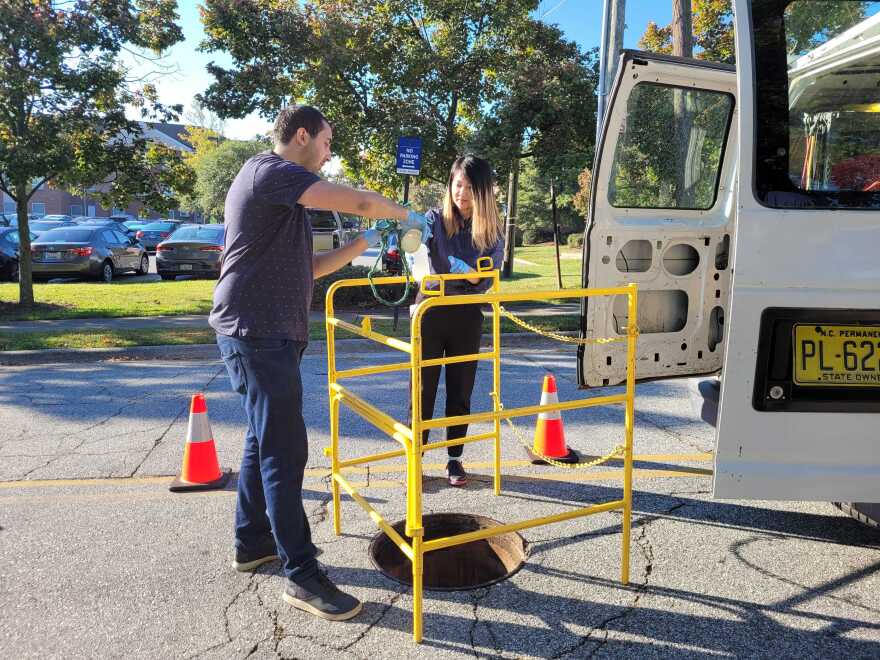Twice a week, a research team at North Carolina A&T State University drives around campus collecting wastewater to test for COVID. The Wastewater Surveillance Team is a crew of three: Professor Dongyang Deng, her PhD student Mehdi Lamssali and the school's plumber, Paul Mabe.
It’s a clear example of university-based research having a real-world impact, Deng says.
“Before individuals start showing symptoms, around two to 14 days before, they're already shedding the SARS-CoV-2 virus into the wastewater,” Deng said.
As one of the most important research campuses in North Carolina, N.C. A&T conducts numerous research efforts like this. The school has been classified as an R2 university — one that exhibits “high research activity.”
The Carnegie Classification of Institutions of Higher Education is in charge of classifying universities’ research activity. The R2 designation is sandwiched between two other categories. Below it is the Doctoral Professional Universities classification. Above it is the R1 designation, reserved for schools that exhibit “very high research activity.”
R1 status is coveted by the collegiate world. It opens doors for big donors and competitive research grants. And N.C. A&T’s Provost Tonya Smith-Jackson said it’s like a microphone for research universities.
“Sometimes people call it the Matthew effect,” Smith-Jackson said. “Where because you're in this classification, you tend to be heard, you tend to be perceived to be more credible, people pay attention.”

The Matthew Effect is a concept about accumulated advantage, where the rich get richer and the poor get poorer.
When R1 universities get funding from donors and grants, it’s used to upgrade research facilities and hire more faculty. These modernized facilities allow for more complex research, and talented staff attracts talented students to run those experiments.
Findings from those studies open the door even more for high-dollar grants and donors. The rich get richer.
To see this R1 university effect in action, Smith-Jackson said to look at the Triangle, where North Carolina’s only R1 institutions — Duke, N.C. State and UNC-Chapel Hill — are based. Research Triangle Park, the largest research park in the U.S., is situated in between the three campuses.
“It's like a magnet being an R1,” Smith-Jackson said. “It just draws people in because they too want to take advantage of that space. Because it signals that innovation is a value.”
N.C. A&T wants to gain R1 status by the end of the decade, but this is no easy feat. Only 4% of U.S. universities hold the designation and they are all historically white.
In the past two decades, not one of the 146 R1 schools has been an HBCU.
Howard University was the only HBCU to ever reach R1 status back in 2000. That was until Carnegie updated its classification formula in 2005 and re-classified Howard as an R2. In total, 11 HBCUs are R2 schools.
Endowed Biology Professor Joseph Graves said while N.C. A&T technically has an R2 designation, they’ve long been operating at an R1 level.
“So, if you rank the UNC system campuses and the research output… We're number three of the entire system,” Graves said.
This year, NC A&T brought in a record $147.4 million research dollars.
The idea that R2 universities might be operating at an R1 level is something Carnegie has also noticed.
Mushtaq Gunja is the Executive Director of Carnegie’s Classification Systems. He said Carnegie uses a relative system to classify universities as R1 or R2. The formula determines which universities have high levels of research activity and then compares them to each other. This peer comparison puts a cap on the number of schools that can be labeled R1.
“There are HBCUs in this country, including N.C. A&T, that are doing incredible amounts of research,” Gunja said. “And I think that we have not traditionally recognized all of the institutions in the country that I think might be doing very high amounts of research.”
N.C. A&T’s research expenditures have had an estimated $157 million dollar impact on the state’s economy. Overall, the school has an estimated economic footprint of $2.4 billion dollars.
Historic Underfunding

Despite its importance in the region, the state of North Carolina has a long history of inequitably funding the school. Last month, the Department of Education found that land grant HBCUs have missed out on more than $12 billion of funding in just the past 30 years.
One of the biggest funding discrepancies was between North Carolina’s two land-grant universities — N.C. State and N.C. A&T — amounting to about $2 billion.
“If you gave me the $2 billion that we are owed by this state,” Graves said. “I could transform the demography of science in this state in a decade, easily.”
Graves teaches classes at both N.C. A&T and N.C. State and said there is a clear difference between their research infrastructure. N.C. A&T has older labs and equipment, as well as fewer research staff.
“And that's because North Carolina State was given the monies that were outlined for them to be able to compete as a premier land grant university and we were not,” Graves said. “And so, it's really that simple. You know, I hate to say it — you get what you pay for.”
This goes back to the Matthew Effect. Schools that were historically underfunded have a harder time competing for grants or attracting big donors. Without that money, these universities don’t have extra to spend on high-end equipment or faculty bonuses.
And in a competition where their peers are billions of dollars ahead, they don’t stand a chance in Carnegie’s relative classification system. The poor get poorer.
“We have so few faculty, that I have to teach courses that nobody else in this department can teach,” Graves said. "So, our students by necessity are getting a truncated biology major, because we don't have the faculty.”
Graves said the underfunding has also impacted the types of students the university attracts.
“We therefore have difficulty attracting top quality graduate students to come to our institution,” Graves said. “Because we have, again, difficulties making sure that they're funded the entire time they’re here.”
More funding for these students is one of the changes N.C. A&T is making on its road to R1 recognition. The school is also creating several new doctoral programs, hiring additional research staff and investing in more advanced labs.

Some of the money for these upgrades is coming from the state. This year’s budget includes a special allocation to help N.C. A&T reach R1: $5 million of nonrecurring funds and $10 million recurring.
“They're committed to an HBCU that can go forward and continue its work and all the implications that go with that research work,” Smith-Jackson said. “And again, it's advancing the quality of life and facilitating economic growth.”
If N.C. A&T earns R1 status, the school’s estimated economic footprint is set to increase to over $3 billion. Smith-Jackson said it could also increase culturally responsive research like investigating health and wealth disparities.
“The community trusts us in doing research to solve problems or to enhance their quality of life,” Smith-Jackson said. “That kind of trust is not quite there for many other institutions. It is there for HBCUs.”
N.C. A&T’s goal is to earn R1 status by 2028, but soon the rules of what makes a “very high research university” may be changing. Gunja says Carnegie is working to adjust the classification system to reflect how higher education has evolved.
“At its core, what we are really hoping to do is to be able to take a fresh look at whether or not in the research category we are accurately capturing who is a very high research activity institution,” Gunja said.
Carnegie plans to release more information about those changes next month.







